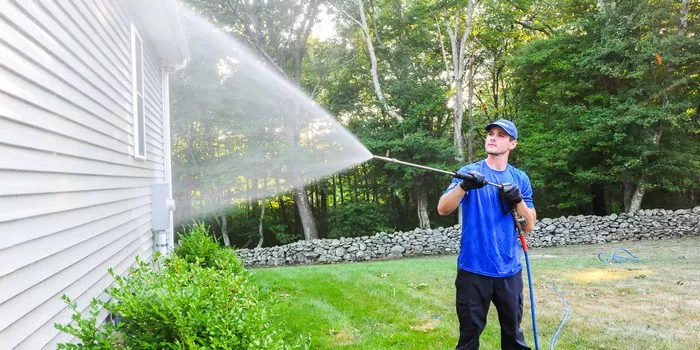Power washing, another name for pressure washing, is a useful technique for cleaning houses as well as other surfaces. Pressure washers can get rid of mold, mildew, filth, grime, and other pollutants from external surfaces and give them back their original look by using high-pressure water spray. However, in order to achieve the best results while preventing damage, pressure washing a property requires careful preparation, the right tools, and skill. We’ll walk you through the procedures and best practices for safely and successfully power cleaning your home in this detailed guide.
Preparing for Pressure Washing
Before you begin pressure washing your house, it’s essential to make thorough preparations to ensure a successful cleaning process and minimize potential risks. Here’s what you need to do:
1. Inspect the Exterior: Take a close look at the exterior of your house to identify any areas that require special attention, such as stains, mildew, or areas with peeling paint. Note any fragile or damaged areas that may need to be avoided or treated with care during the pressure washing process.
2. Gather Equipment and Supplies: Gather all the necessary equipment and supplies for pressure washing, including a pressure washer with appropriate PSI (pounds per square inch) for house cleaning, extension wand, nozzles (preferably adjustable), cleaning solutions (if needed), safety gear (goggles, gloves, and appropriate clothing), and a ladder if you need to reach high areas.
3. Protect Surrounding Areas: Cover or remove any delicate plants, outdoor furniture, or decorations near the house to prevent damage from the high-pressure water spray. Additionally, close windows and doors tightly to prevent water from seeping inside the house.
4. Test Pressure Washer Settings: Before starting the cleaning process, test the pressure washer on a small, inconspicuous area of your house to ensure that the pressure and spray pattern are appropriate and will not cause damage to the surface.
Pressure Washing Techniques
Now that you’ve made the necessary preparations, it’s time to start pressure washing your house. Follow these techniques to achieve the best results:
1. Start from the Top: Begin pressure washing at the top of your house and work your way down. This ensures that dirt and debris are washed away from clean areas and prevents streaking or recontamination of cleaned surfaces. Use an extension wand to reach high areas safely.
2. Maintain Proper Distance: Keep the pressure washer nozzle at a consistent distance from the surface you’re cleaning, typically around 6 to 12 inches. Holding the nozzle too close can cause damage, while holding it too far away may reduce cleaning effectiveness.
3. Use the Right Nozzle: Select the appropriate nozzle for the job. For most house washing tasks, a wide-angle or fan nozzle is suitable. Adjust the nozzle to control the spray pattern and pressure according to the surface being cleaned.
4. Work in Sections: Divide the exterior of your house into manageable sections and focus on cleaning one section at a time. This allows you to give proper attention to each area and ensures thorough cleaning.
5. Overlap Strokes: When moving the pressure washer wand across the surface, overlap each stroke slightly to ensure even cleaning and prevent streaking. Work methodically, covering the entire area with overlapping passes.
6. Use Proper Technique: Hold the pressure washer wand at a slight angle to the surface, rather than pointing it directly at the surface, to prevent gouging or etching. Move the wand in a consistent, smooth motion, avoiding rapid or jerky movements.
7. Treat Stubborn Stains: For stubborn stains, mold, or mildew, you may need to use a cleaning solution in conjunction with the pressure washer. Apply the solution to the affected area, allow it to dwell for a few minutes, then use the pressure washer to rinse it away.
8. Rinse Thoroughly: After cleaning each section, thoroughly rinse the surface with clean water to remove any remaining detergent or debris. Failure to rinse properly can leave behind residue or streaks.
9. Be Mindful of Surfaces: Adjust the pressure washer settings and technique according to the type of surface you’re cleaning. For example, softer surfaces like wood or vinyl siding may require lower pressure to prevent damage.
10. Work Safely: Always prioritize safety when pressure washing your house. Wear appropriate protective gear, including goggles and gloves, to shield yourself from debris and chemicals. Be cautious when using ladders or working at heights.
Post-Cleaning Care and Maintenance
Once you’ve completed pressure washing your house, there are a few additional steps you can take to maintain its cleanliness and prolong the results:
1. Inspect for Damage: After pressure washing, inspect the exterior of your house for any signs of damage, such as peeling paint, loose siding, or cracks. Address any issues promptly to prevent further deterioration.
2. Allow Time to Dry: Allow the surfaces to dry completely before inspecting the results or undertaking any further maintenance or painting projects. This typically takes a few hours, depending on weather conditions.
3. Consider Sealing or Painting: Depending on the condition of your house’s exterior, you may want to consider applying a protective sealant or repainting surfaces to enhance durability and appearance.
4. Regular Maintenance: To keep your house looking its best, establish a regular maintenance routine that includes periodic cleaning with a pressure washer. This helps prevent dirt, mold, and mildew buildup and extends the lifespan of exterior surfaces.
5. Consult Professionals: If you’re unsure about pressure washing techniques or concerned about potential damage to your house, consider consulting with a professional pressure washing service. They can provide expert advice and assistance to ensure optimal results.
You may successfully pressure wash your home to get rid of dirt, filth, and other impurities, improving curb appeal and giving it a new look. Just remember to follow these suggestions and practices. Prioritize safety, appropriate tools, and skill to get the best results without endangering the external surfaces of your house. Your house will remain clean and well-maintained for many years to come with routine care and upkeep.

